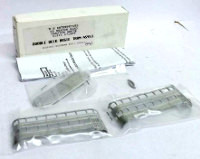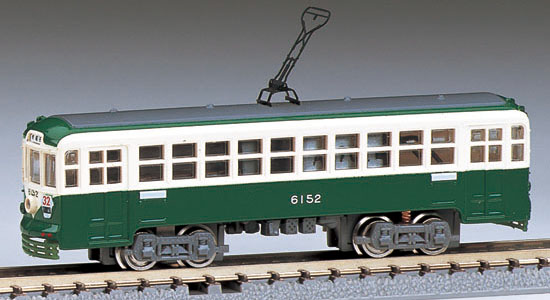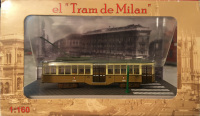
I have retrospectively pieced together the following summary of milestones and products in the history of N gauge trolley modeling. It is based on available information gleaned from the items themselves, old magazine ads, articles, webpages and particularly the various documents produced by the NCat group. This group pioneered and pursued model traction operations in N scale, using enhanced Ntrak modules and live overhead wire to power trolleys and electric locomotives.
Over the past half-century the hobby has changed dramatically. Originally, scratchbuilding or intense "kit-bashing" was a necessity, using modified locomotive chassis or making homemade power. Today, far simpler trolley modeling is now readily possible. Ready-to-run trolleys and trams, ready-made tight radius sectional track (including paved street track) and track switches, affordable smooth-running small power chassis, pre-assembled buildings, and 3D printing are all available. Some dedicated modelers still scratchbuild models and pursue working, electrified overhead in N-gauge, which the pioneering modelers proved was possible to do. Many more enthusiasts now simply purchase and enjoy quality products. - R. D. Kerr
|
1962: The Arnold company of Germany introduced "N gauge" with its 1:160-based scale model railroad product line. The “N” stood for “Neun” (the German word for “Nine”) millimeters, the gauge distance between the rail heads. This was the first commercially produced N-gauge equipment. | |
|
Pre-1971: People generally thought that operational model trolleys in N-gauge were simply not possible, because the motors and drive trains available were too large to fit in a model trolley in that small scale. | |
|
1971: The October 1971 Railroad Model Craftsman magazine showed photos and a power truck diagram for a motorized N-gauge Niles interurban model scratchbuilt by Philip Lehr. The December 1974 issue showed three additional powered trolley models built by him. Philip's pioneering work was an eye-opener for other modelers. Thanks to Alex Procyk, this website now includes color images and background information for Philip Lehr's pioneering N-scale trolley models. |

|
|
1972: The December 1972 Traction and Models magazine showed an unpowered N-gauge model streetcar scratchbuilt by Richard Orr of Omaha, Nebraska, an early producer of HO finescale overhead wire fittings and trackwork. |

|
|
1973 - Present: Scenic accessory white-metal kits for various British trams have been produced in the United Kingdom by several manufacturers, beginning in 1973 in Crawley, Sussex, England, when Cromer Models produced an N scale "Brill E-Type Tram" kit for a static 4-wheel open-top double deck tram. (The exploded parts drawing in the kit instructions was signed and dated by Pete Allen in 1973.) Cromer's instruction sheet indicated that a "a mechanised unit is in preparation." This kit was transferred to Thameshead Models in the 1980s, Invictascene in the 1990s, and BH Enterprises as item TM16 in 1998. BH Enterprises also lists a closed-top variation of TM16 as its item NS451. |

|
|
In the 1980s D & M Quality Accessories began making a 4-wheel closed-top double deck tram kit, which came with a static white-metal chassis but was also billed as a "direct fit" on a Lima powered chassis. This kit was transferred, similarly to the Cromer Models kit, to Invictascene in the 1980s and BH Enterprises in 1998, becoming their item NS450. |

|
|
A longer "bogie" version of the former D & M kit is sold by BH Enterprises as item NS453, which can fit the Bachmann Brill Trolley chassis. An open-top variation of NS453 is sold as NS454. They also sell a "Four Wheel Closed Top Double Deck Tram" as NS450, plus a "Large Closed Top 4 Wheel Tram" as NS452, which they say can be powered by a Grafar bogie or Greenmax 502 chassis.
Started by John Harries in about 2010, KW Trams has produced many kits in multiple scales, but just one in N, the KW200 2-axle tram, which comes with parts to construct either an open top or a balcony top tram. |

|
| 1974: Hal Riegger of California participated in the first Ntrak modular layout set-up, at the 1974 National Model Railroad Association (NMRA) convention in San Diego, California. His module featured working live overhead operation, with a scratchbuilt small freelance mine locomotive running under about eight feet of overhead wire. Hal Riegger is considered the "father" of N-scale traction modeling using live overhead. |
 |
|
1974 - 1975: Bruce Smith’s Western Railcraft of Phoenix, Arizona produced craftsman-level etched brass interurban model kits in 1:160 scale. These kits included photo-etched brass sides, doors and ends (the latter had to be hand-curved or assembled from multiple pieces), plus a unshaped wood block for the roof and other small pieces of wood and brass wire. How to power the model was left up to the model builder. Because of the modeling skill they required, most of these kits remain unbuilt today. |
 |
|
1977: At the NMRA convention in Denver, Colorado, five modelers with 24 feet of modules featuring overhead operation participated in an Ntrak layout. Soon after, the name “NCat” was devised for these enhanced Ntrak modules, and a newsletter group was formed under this banner to focus on N scale electric traction. NCat formalized standards and methods for the modules, overhead wire construction, working trolley pole construction and wiring methodology in over 70 “data sheets.” | |
|
1977: A Hal Riegger article “Traction Wire Work” in the October 1977 NMRA Bulletin showed his N-gauge operational overhead wire. A follow-up article “Live Overhead Systems for 1:160 Scale” in the September 1978 issue detailed construction methods for overhead, trolley poles and pantographs, with photos of his layout and electric locomotives. | |
|
1970s?: Jack Mealey's Adina Corporation of Cornwells Heights, Pennsylvania produced two cast metal one-piece bodyshells, along with fastasy figures, N scale people and other cast items. The trolley shells are thick, with the windows solid rather than being open. The single-truck Birney safety car shell is marked "DINA CORP. N-BR-1" on the underside of the roof, apparently because one of the cast-in round chassis mounting posts near each end obscured the first letter in ADINA. The Model Power Brill Trolley chassis fits into this shell. The 1947 PCC body (Item No. 101) is unmarked inside and has square chassis mounting posts integral to its ends. It is longer and thinner than the common plastic Bachmann PCC. Both shells are oversize. I have been unable to determine precisely when these were made. |

|

| |
|
1981: Model Power introduced the first ready-to-run N-gauge model trolley. It was an operating 2-rail model manufactured by Mehano of Yugoslavia. At the time, the model's drive chassis seemed amazingly small. The models were sold as two-car motor/trailer pairs in four paint schemes. They came with a wrench for the motor brushholder. |

|
|
1982: Bachmann Plastics of Philadelphia, Pennsylvania added a ready-to-run N-gauge Brill Trolley to its extensive multi-scale model product line. The operating 2-rail model represented a J. G. Brill deck roof, double truck semi-convertible, a prototype design that saw wide use in the U.S. In 1983 Bachmann added a second N-gauge trolley model to its product line, representing the widely-used streamlined PCC Streetcar. Both of these early Bachmann models have had long production runs and are plentiful, but I can not recommend them. The plastic axle gears, both the early white and later black ones, have a habit of cracking, making the cars inoperable. On the other hand, Bachmann's newer Peter Witt Streetcar, introduced in late 2010 but unfortunately discontinued in 2018, was a quality product up to modern standards, with built-in DCC (runs on plain DC, too) and excellent operation. |

|
 | |
|
1987: George Barsky’s GHB International of Gaithersburg, Maryland has over the years produced and imported an eclectic variety of railway models in a range of scales, from N to 1/2-inch. In 1987 GHB commissioned and imported operating 1:160 N-scale brass models of Illinois Terminal System #273, an interurban combine car, made in Korea by F. M. Models. This appears to be the only N scale "brass import" trolley model ever offered in the U.S. market. In 2010 GHB began working with Mike Bartel of Imperial Hobby Productions (see below) to offer two resin-cast streetcar body shells, sized to fit the Bachmann Brill trolley power chassis. |

|
|
About 1991: By January 1991, an informal NCat Newsletter was being published. It was followed that December by the more substantial NCat News which then continued, generally bimonthly, through December 2001, with subsequent annual "Special Issues" produced, after a time gap, for 2004 through 2006. Over time the NCat group reached a peak membership of over 90 members, although only a small number of them actually built operating modules or layouts. They adapted the drives from small railroad switching locomotives, Bachmann trolleys and other early sources. | |
|
About 1995 - About 1997: Bob Fabris’ Porthole Productions of San Jose, California offered cast resin shells for an Illinois Terminal Class B electric locomotive and a Pittsburgh variant of the PCC car. A shell for an articulated four-truck Illinois Terminal Class C electric locomotive was added later. (The Class C shell is very similar to the Class B and is the one shown in the photo.) |
 |
|
1996 - 2010: Kato of Japan produced over 30 livery variations of a ready-to-run 2-rail powered N scale German Duewag T2 2-axle tram, with an unwired sprung metal pantograph. The majority of these products consisted of a 2-car set, the second car being a matching trailer with a coupling bar. Most of them were made for European distributor Wolfgang Lemke GmbH of Germany. |

|
|
1996: Working live outside third rail operation in N-gauge was demonstrated at the Ntrak convention in Long Beach, California. | |
|
1997: In the Jan.-Feb., Mar.-Apr., and May-June 1997 issues of NCat News (reprinted in the NCat Project Book 3), Hal Riegger detailed construction methods for working outside third rail operation in N scale. | |
|
1997 - 2015: Between 1997 and 2000, Arnold of Germany produced nearly 20 operating 1:160 scale Düwag GT6 6-axle articulated trams, with a flywheel-equipped drive, working blackened metal pantograph and a 2-rail/pantograph selector switch. After Arnold was bought by Hornby Models, the GT6 models were reintroduced in 2013. These have a new digital-capable chassis design and an unwired sprung metal pantograph. A few new models have been introduced every few years. |

|
 | |
|
About 1997 - Present: Hasegawa, a large Japanese model kit manufacturer, has produced its extensive Modemo line of 1:150 scale, 2-rail, ready-to-run tram, light rail and electric railway passenger equipment, all modeled after Japanese prototypes. |

|
|
1990s: Raintree Products International, Inc. sold, among other resin castings, N scale trolley shells. John Kreider’s Father Nature model railroad scenery business of Pennsylvania bought this product line and offered it at least between 1999 and 2006 as part of its line of railroad locomotive and other miscellaneous resin shells. The trolley shells were based on masters made by prolific early N trolley modeler Jim Brewer. Brewer had earlier made copies of some of his models using white-metal castings for sides and ends, and shaped wood roofs with round-topped copper brads to represent ventilators. At least three of the Brewer designs offered as resin shells by Raintree Products and later Father Nature have also surfaced as completed models assembled from these cast metal parts, one of them in multiple copies. |

|
 | |
|
2000-2007: Mike Bartel's Imperial Hobby Productions of Wynnewood, Pennsylvania focused on 1:700 scale cast metal waterline ship models and model U.S. commuter rail, rapid transit and trolley products. The offerings grew to include cast resin HO scale carbody shells, and later some in 1:48 O-scale. 1:160 N-scale cast resin trolley shells were introduced in 2000. |
 |
|
2003: Günther Hödl's Linie8 GmbH of Germany added 1:160 N scale operating models of Siemens Combino articulated trams to its multi-scale product line. He offered five models, some 3 sections long and some 5 sections long. Two were of prototypes operating in Japan, with the other three operating in Germany. These models feature clever design and their carbody liveries are simply painted onto clear plastic bodyshell sections. This model design was reincarnated in late 2023 with new liveries as non-powered additions to the Rietze Auto Modelle product line. |

|
|
2005 - Present: In Japan, Tomytec (part of the Takara Tomy Co. Ltd. toy empire, along with the Tomix model railroad brand) has produced many, many Tetsudou Railway Collection 1:150 scale unpowered models. Garth Hamilton's webpage, preserved here, lists those from 2005 through 2008, but in fact there are far too many for me to hope to list and illustrate. Beyond the hundreds listed on the Hobby Search Japan website, there are also special releases made available only at hobby shows, railway open house events and so on. In addition, Tomytec has produced over 20 suitable snap-in power chassis in multiple sizes, so that all of these models can easily be made operable. Many of these Japanese prototypes are tram, light rail, and interurban electric railway designs. A smaller World Railway Collection product line, launched in 2017, offers models of European trams, in apparent partnership with distributors there. | |
|
2005: Tomix, a model railway product line of Takara Tomy Co. Ltd., added curved track in three tight radii and matching turnouts, suitable for model tram and trolley layouts, to its extensive range of sectional track. In 2006 Tomix added a plastic “paving” overlay kit to convert these Mini curves (177 and 140 mm radius), Super Mini curves (103 mm radius) and Mini turnouts (140 mm radius diverging track), as well as straight and crossing sectional track pieces, into paved street trackage. | |
|
2009: Kato of Japan began selling 1:150 scale models of the 2-section articulated Toyama Portram light rail trams and introduced its Unitram system of double-track streetcar tracks. (This system provides not only the tracks, but also incorporates adjoining traffic lanes, sidewalks and modular sections of city blocks.) Liveries for other tram lines in Japan followed in 2010 and 2011. Prior to these, Kato had begun offering its Hannover / Hiroshima 2-axle tram, to which it added a fictional 4-wheel electric steeplecab locomotive and a 2-car boxy "people mover"-styled "Chibi-Den" tram in a more toylike Pocket Line series. Kato later added tight-radius curves and a pair of matching track switches as Compact series additions to its Unitrak sectional track system. In 2020 the company introduced its first models of the Hiroshima 1000-series "Greenmover LEX" articulated tram, which features very small drive units and a detailed interior. | |
|
2009 - 2011: Eric Courtney’s Miniatures by Eric in Alberta, Canada developed and sold more than 20 designs of cast resin N scale trolley shells. He later discontinued making and selling these, but he continued to sell three styles of well-made sprung N scale trolley poles, built of brass with lost wax castings. |
 |
|
2010: Tomix started production of its Wide Tram pre-paved street railway curved sections (Mini and Super Mini), straight track sections and a 90-degree crossing. Tomix also added a second paving kit that matches the color and surface texture of the pre-made Wide Tram pieces, allowing modelers to pave turnouts and create customized applications. Compatible sectional roadway pieces were added beginning in 2011 as part of Tomytec's Moving Bus System, which features operating battery-powered, self-steering model buses. | |
|
2010 - 2019: In 2010 the 80M Model Bus Shop in Hong Kong started selling inexpensive but well-made static 1:150 models of Hong Kong Tramways distinctive double-deck trams. Popular with both residents and tourists, the models were appealingly packaged on street scene bases in clear plastic display boxes, all enclosed in decoratively printed cardstock sleeves with view openings. Modelers have disassembled and powered these with various power chassis, my preference being a stripped-down Tomytec TM-TR02. |
 |
|
2010: Australian diecast vehicle producer Cooee Concepts added 1:160 N scale models of the iconic Melbourne W6 Class tram to its product offerings, decorated for both Melbourne and Bendigo prototypes. These models are somewhat crude, with solid rather than open window areas, rounded detail lines, and trolley poles represented by cast ridges on the roof. They were sold as collectible models, as well as in a keyring version. |
 |
|
2011: Oxford Diecast Ltd., a well-known manufacturer of static metal diecast vehicle models, added 1:148 scale tram models to their offerings beginning in 2011. These inexpensive and well-decorated models are based on a classic Dick, Kerr and Co. double-deck tram design once common in Great Britain. Naturally, modelers with a hunger for British tram models have found a way, and taken the effort, to motorize these using small N-gauge power chassis made by other manufacturers. |
 |
|
2012 - Present: Tramway in Japan, associated with Dauphin Ltd., produced 1:150 N-gauge models of various classes of Tokyo "Toden" trams, either as complete operating models or as body shell kits and separate power chassis. |
 |
|
2012: A.C.M.E., an Italian model train producer better known for HO models, introduced 8 varied display models of Milan "Peter Witt" style trams in 1:160 scale. These were good-looking, well-detailed static models, sold in attractive plastic display cases, in a manner very similar to the Hong Kong tram models of M80 Model Bus Shop. A Tomytec TM-TR01 powered chassis can be carved down and made to fit into these shells. |
 |
|
2015 - 2017: Hobbytrain, a brand of Wolfgang Lemke GmbH of Germany, first produced 1:160 N-gauge models of modern Düwag M6 6-axle articulated trams in 2015. Although announced in 2011, the first three models did not actually appear for sale until late 2015 and early 2016. In 2017 a model of the longer three-section Düwag M8 8-axle tram was added to this product line. All of these models were made in South Korea for the Lemke Hobbytrain brand. |

|

| |